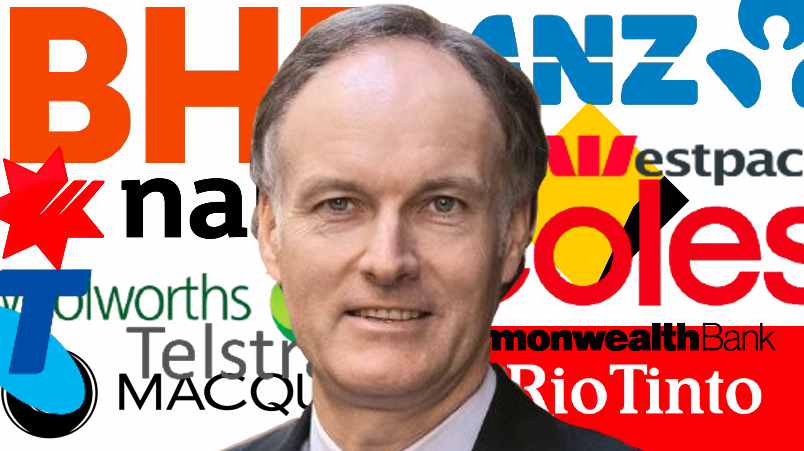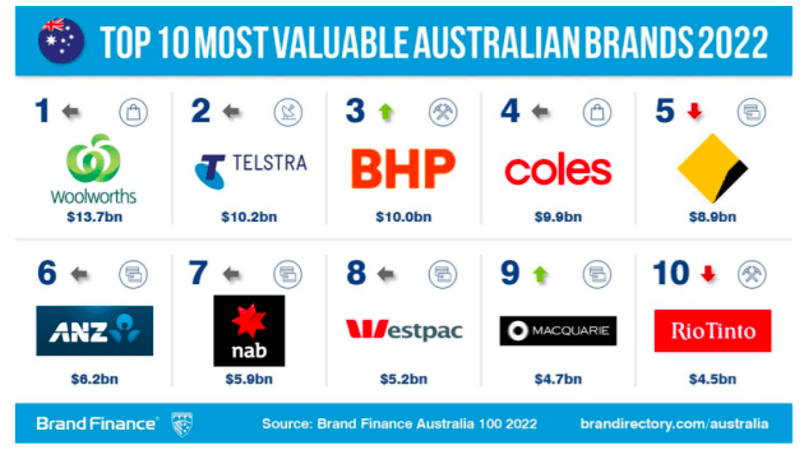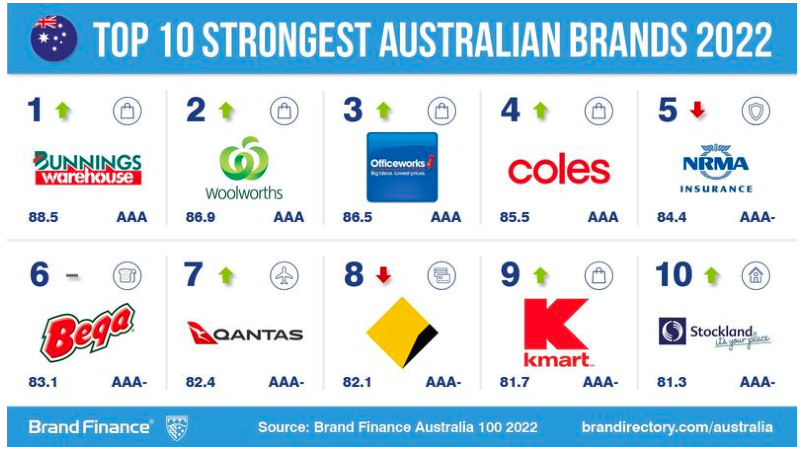Marketing's $400bn bottom line: Brand Finance chief on Woolies, NRMA surge, Milo losing ‘iconic’ status; marketers turning to brand valuations to woo CFO, boost budgets – but still left out of M&A brand value, future cashflow conversations

Brand Finance MD Mark Crowe: "If you're not measuring that 70 per cent of intangible value, then it's very hard to understand what's happening with the business – and that's where boards get nervous."
Nestle’s Milo brand is in danger of losing its status as an iconic brand in Australia, Brand Finance Managing Director Mark Crowe says, unpacking the leaders and laggards in the latest Top 100 most valuable brand rankings, where 66 brands rose and 22 fell. But brand value and strength are more than just 'soft metric' leaderboards – they’re being leveraged in hard financial terms by CFOs and CEOs in M&A negotiations and Crowe thinks marketers should be brought into those deals much earlier. A case in point, he says, is that analysts hungry for future cashflow indicators are driving demand for brand valuations. Meanwhile agencies and marketers have woken up to the fact they can demonstrate their direct impact on a brand by measuring the change over time – a major factor in NRMA landing the 2021 Grand Effie.
What you need to know:
- Marketers are turning to brand valuations to prove investment is paying off and grow – or at least maintain – budgets.
- They are not the only ones. Investment analysts are also driving demand for detail on brand strength and value as an indicator of future cashflows when running the rule on corporate financials.
- Brand Finance Director Mark Crowe says brand value and strength are increasingly being factored into M&A deals for the same reason. He says there is a certain irony in marketers often being last at the table in those conversations.
- Brand Finance's most recent rankings put Woolworths, Telstra, BHP, Coles and CommBank in the top spots.
- In the most recent Top 100 list, 66 brands increased their value and 22 fell.
- But Crowe says declining brand value isn’t always about poor marketing, there can be economic factors – freight companies like Aurizon lost value due to trade friction with China.
- Though some declines may be down to investment, strategy or changing consumer habits: Milo is losing its status as an iconic brand, Crowe says, dropping gradually but consistently over time.
- He thinks the smarter agencies have grasped that brand valuations can better convince clients that their strategies – and work – is literally paying dividends.
From a board's perspective, from a CEO or CFO's perspective, and certainly from a market's perspective, you can't ignore the value that asset brings to the business, not only in terms of relative value to other assets, but how much that value is contributing economic value to the brand owner.
In last year’s Effies Awards, NRMA showed its brand value had risen by $300 million over the past few years. It took out the top gong. It went from 36th to third in brand strength, outgoing CMO Brent Smart said in an interview with Mi3.
Now Brand Finance says there’s a resurgence of interest in brand strength metrics which, crucially, is going well beyond the marketing department. C-suite execs, investors and boards are starting to understand the value of brands.
Media and everything around marketing accounts for $32 billion of spend each year, Brand Finance’s Managing Director, Mark Crowe, says. But the “intangible assets”, like the value of brands, add another $400 billion. The top 100 account for $161bn of that, with Woolworths, Telstra, BHP, Coles and CommBank at the top of the pack.
“Ultimately, when you look at a brand, you're saying ‘how much of a premium does a brand generate for this business as opposed to this business if it wasn't branded at all? How much premium does the brand bring to the business?” Crowe says.
“And if you don't understand that, then it's very difficult to understand the role the brand is playing in business success and how much economic value it's driving ultimately for the business year on year.”
In the 2022 Brand Finance rankings, 66 brands in the top 100 increased their value. But 22 declined.
Why growers grow
At the top of the pack was Woolworths, whose brand value was put at $13.7bn. Telstra ($10.2bn), BHP ($10.0bn), Coles ($9.9bn) and CommBank ($8.9bn) followed, clawing back value lost during the pandemic.
“The interesting things we observe is during challenging times, it's often the iconic brands, the strong brands that come to the fore because they have invested in a lot of equity over time,” Crowe says. He thinks three brands stand out in that regard.
NRMA is now not only the strongest insurance brand, it’s the strongest in the financial services industry. Qantas, likewise, continued brand investment during the pandemic – notwithstanding recent turmoil – and “they’ve come out a lot stronger and returned to their previous brand ranking,” per Crowe.
Mining giant BHP has dug deep into brand coffers in recent years, strengthening ties with government, community and investors. “It's built up a lot of equity through a very sound marketing strategy aimed very much at those areas which don't necessarily generate revenue but save on cost,” Crowe says.
Brand Strength and Brand Value are core metrics calculated by Brand Finance. Brand Strength is a measure of three areas: The quality of investment in the brand, the equity the brand holds, and financial performance. Brand Value is the value of the economic benefits brought by using a brand.

The top 10 most valuable Australian brands in 2022, according to Brand Finance.
It's often only at the point of time in a deal during an M&A, where we may be bought in... ironically, there's not many marketers sitting around the table when that's happening.
Why decliners decline
While 22 brands suffered declines in value over the past year, marketers shouldn't take the fall in all cases, Crowe argues. Dulux is a case in point. “[They] have suffered due to rising costs – but importantly they've maintained their brand strength,” Crowe says. “So the branding itself has really helped fortify the business against rising costs and declining margins.”
Likewise construction company Boral fell, due to a drop in construction work and related supply chain issues, while Aurizon and Transurban can point to similar challenges compounded by economic and environmental challenges – think trade friction with China.
Crowe thinks many of those that declined have done the best they could with the hand dealt to them.
“A lot of these brands still have maintained their strength and that's really fortified them in terms of minimising the impact of those market conditions but placing them in a good position in terms of when they come out of the pandemic as well,” Crowe says.
Interestingly, Milo also fell. “It's continuing to decline over time as it is starting to lose its position as an iconic brand,” Crowe says, “with a drop in consideration and familiarity.”
Why the rise?
Brand valuation is growing in stature because agencies and marketers are looking to quantify and validate their work. If an agency can demonstrate an increase in a client’s value, they can, essentially, demonstrate their effectiveness in adding to the bottom line. Per Crowe’s work, brand and the “intangibles” can account for up to 70 per cent of a brand’s overall business value.
“It gives a far greater scale of understanding of the responsibility marketers bring to the table when you talk about marketers, rather than what might be the size of the budget, but rather the assets they're valuing within the business, of which brand is the prime value creating asset,” Crowe says.
“When you're looking at the top 10, that’s worth billions of dollars.”
Agencies can cop flak for often working hand to mouth, but “there’s some good work, some good thinking”, Crowe adds. He thinks the smarter operators are fully weaponising brand valuation and strength metrics in order to win and retain more clients.
“Some of the traditional agencies, they've got those traditional measures, and no one seems to question them – so everyone happily goes along. But sometimes those traditional measures only represent about 30 per cent of the whole effort and contribution,” he says.
“From a board's perspective, from a CEO or CFO's perspective, and certainly from a market's perspective, you can't ignore the value that asset brings to the business, not only in terms of relative value to other assets, but how much that value is contributing economic value to the brand owner.”
The asset-marketing brand disconnect
Brand Finance works with marketers and agencies, but also with C-suite execs going through the sale of a business – that’s when the value of a brand can make a real difference to a bottom-line figure. But Crowe thinks there's one obvious gap around the table.

The top 10 strongest Australian brands in 2022, according to Brand Finance.
“It's often only at the point of time in a deal during an M&A, where we may be bought in. It's not at the beginning, more towards the end, where they're saying ‘we really need to get a fix now on just what value the brand along with these other intangible assets is worth’. That's where the interest is – and these are big deals. Ironically, there's not many marketers sitting around the table when that's happening,” says Crowe.
“That's why we need to get away from marketing spend to really looking at brand in terms of an asset and how much value it's generating – in the world of finance and deals, brand is very much seen as key.”
Banks, telcos, retailers building brand
Industries piling into brand value are those that are managing uncertainty, both technologically and economically. Banks, for example, want to demonstrate their size, scale and market share in any way they can. Telcos face constant – major – changes in tech, and want to know how their brand is being affected. Interestingly, retailers have always invested in understanding brand value.
“It's all about converting those percentages into financial value. Then suddenly you're having that discussion with CFO is not on the basis of a cost of investment, but rather how much the investment will realise in terms of added value, not only to the brand, but to the business overall. [That’s a] far easier way to discuss what is the right budget setting,” Crowe says.
It's often difficult to get a board excited about ‘consideration’ being up 15 per cent because the board will say ‘that sounds good, but what does it mean in terms of how much more money is putting into our till’? So again, it gets back to converting percentages into dollar signs and that's really what it's about.
Not so soft metrics
Crow bristles when asked whether Brand Finance is perceived as assessing “soft” metrics. Not so, he insists.
“It's all down to language in many respects,” he says. “It's often difficult to get a board excited about ‘consideration’ being up 15 per cent because the board will say ‘that sounds good, but what does it mean in terms of how much more money is putting into our till’?
"So it gets back to converting percentages into dollar signs and that's really what it's about. Suddenly those 'soft' measures, as one may refer to them, become hard measures. And more importantly, they become robust measures… If you're not measuring that 70 per cent of intangible value, then it's very hard to understand what's happening with the business – and that's where boards get nervous.”
Marketer strength is future brand strength
In one sense, accountants are historians of a company – they measure what has happened in the past. Marketing, conversely, is the signpost of the future – it’s about what’s going to happen next in a brand. And that flows through to the internal team as much as the messages going out into the broader market.
“In any downturn, that's always the opportunity to grow market share, when the cost of [share of] voice is often less. Understanding your brand becomes important in knowing in which area of focus the brand should be positioned,” Crowe says.
“Using the retail example, a lot of the emphasis in terms of brand strategy wasn't necessarily towards the customer, but those other stakeholders, who were under similar pressure and who were nervous, be it suppliers, distributors, financiers. Of course, one of the most important areas of branding is the whole internal marketing – ensuring every employee in the business understands the brand and knows what strength the brand brings to that business, which gives employees confidence that this is a good business and brand to be associated with."
Regardless of how economic headwinds play out, Crowe thinks marketers can plot a clear value path for company leaders and investors by better articulating their brand's intangible value – and the correlation with future cashflows.
"Analysts external to businesses are very much driving that discussion at the moment, because they're often saying we understand your P&L, we understand your balance sheet, we've read your annual report. That's great, good to hear. But what are the signposts of the future? ... And that's led by brand. So in many respects, marketing has got the opportunity to really dominate where the growth is in businesses, in intangible value, led by brand."

